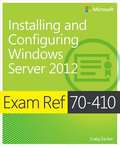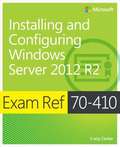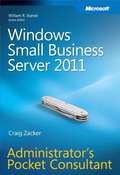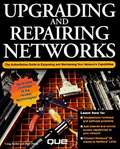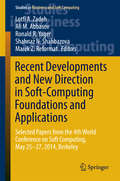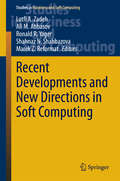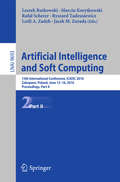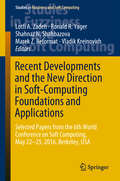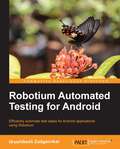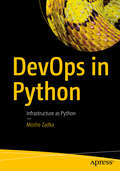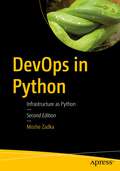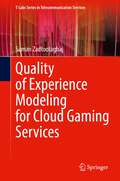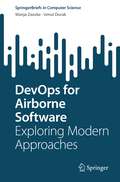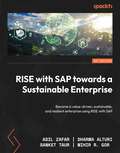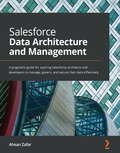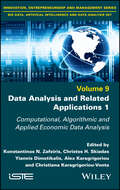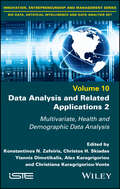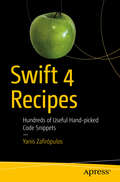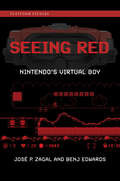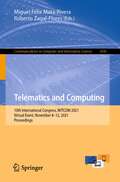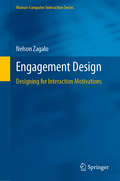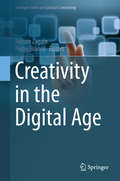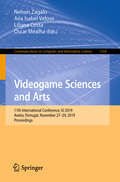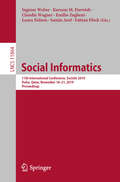- Table View
- List View
Exam Ref 70-410: Installing and Configuring Windows Server® 2012
by Craig Zacker<p>Organized by exam objectives, Exam Ref 70-410 focuses on the critical skills and knowledge needed to implement and configure Windows Server 2012 core services in an enterprise environment.</p>
Exam Ref 70-410: Installing and Configuring Windows Server 2012 R2
by Craig ZackerFully updated for Windows Server 2012 R2! Prepare for Microsoft Exam 70-410 - and help demonstrate your real-world mastery of implementing and configuring core services in Windows Server 2012 R2. Designed for experienced IT professionals ready to advance their status, Exam Ref focuses on the critical thinking and decision making acumen needed for success at the MCSA level. Focus on the expertise measured by these objectives:Install and configure servers Configure server roles and features Configure Hyper-V Deploy and configure core network services Install and administer Active Directory Create and manage Group Policy This Microsoft Exam Ref:Organizes its coverage by exam objectives. Features strategic, what-if scenarios to challenge you.
Windows® Small Business Server 2011 Administrator's Pocket Consultant
by Craig ZackerPortable and precise, this pocket-sized guide delivers ready answers for administering Windows Small Business Server 2011 Standard. Zero in on core support and maintenance tasks using quick-reference tables, instructions, and lists. You'll get the focused information you need to solve problems and get the job done--whether at your desk or in the field. Get fast facts to: Install Windows Small Business Server 2011 on-premise Use Active Directory® to manage computers and users Handle core administrative tasks with the console Use permissions to control access to network resources Manage your data storage resources Administer email with Microsoft® Exchange Server 2010 Monitor the performance of your servers and workstations Build an intranet with Microsoft SharePoint® 2010 Migrate an existing network
Upgrading and Repairing Networks
by Craig Zacker Paul DoyleA well-rounded source for all network needs, whether upgrades, troubleshooting, expansion, or repair. General "buyer's guide" information helps the reader make decisions while the abundance of how-to and troubleshooting tips helps with the day-to-day maintenance and operation tasks.
Recent Developments and New Direction in Soft-Computing Foundations and Applications
by Lotfi A. Zadeh Ali M. Abbasov Ronald R. Yager Shahnaz N. Shahbazova Marek Z. ReformatThis book reports on advancedtheories and cutting-edge applications in the field of soft computing. Theindividual chapters, written by leading researchers, are based on contributionspresented during the 4th World Conference on Soft Computing, held May 25-27,2014, in Berkeley. The book covers a wealth of key topics in soft computing,focusing on both fundamental aspects and applications. The former include fuzzymathematics, type-2 fuzzy sets, evolutionary-based optimization, aggregationand neural networks, while the latter include soft computing in data analysis,image processing, decision-making, classification, series prediction,economics, control, and modeling. By providing readers with a timely,authoritative view on the field, and by discussing thought-provokingdevelopments and challenges, the book will foster new research directions inthe diverse areas of soft computing.
Recent Developments and New Directions in Soft Computing
by Lotfi A. Zadeh Ali M. Abbasov Ronald R. Yager Shahnaz N. Shahbazova Marek Z. ReformatThe book reports on the latest advances and challenges of soft computing. It gathers original scientific contributions written by top scientists in the field and covering theories, methods and applications in a number of research areas related to soft-computing, such as decision-making, probabilistic reasoning, image processing, control, neural networks and data analysis.
Artificial Intelligence and Soft Computing: 15th International Conference, ICAISC 2016, Zakopane, Poland, June 12-16, 2016, Proceedings, Part II (Lecture Notes in Computer Science #9693)
by Lotfi A. Zadeh Leszek Rutkowski Marcin Korytkowski Rafał Scherer Ryszard Tadeusiewicz Jacek M. ZuradaThis volume constitutes the proceedings of the 7th Conference on Arti?cial Intelligence and Soft Computing, ICAISC2004, held in Zakopane, Poland, June 7 11, 2004. The conference was organized by the Polish Neural Network Society in cooperation with the Department of Computer Engineering at the Tech- calUniversityofCzesto, chowa, WSHE University in L od z and IEEE Neural Networks Society. The previous conferences took place in Kule (1994), Szczyrk (1996), Kule (1997) and Zakopane (1999, 2000, 2002) and attracted a large number of papers and internationally recognized speakers: Prof. Lot? A. Zadeh, Prof. RobertMarks, Prof. EnriqueRuspini, Prof. Zdzis lawBubnicki, Prof. Jacek ? Zurada, Prof. Shun-ichi Amari, Prof. Kaoru Hirota, Prof. Ryszard Tadeusiewicz, Prof. Shiro Usui, Prof. W lodzis law Duch, Prof. Erkki Oja, Prof. Syozo Yasui, Prof. Witold Pedrycz, Prof. Janusz Kacprzyk, Prof. Laszlo T. Koczy, Prof. Soo- Young Lee and Prof. Daniel Amit. The aim of this conference is to build a bridge between traditional arti?cial intelligence techniques and recently developed soft computing techniques. It was pointed out by Prof. Lot? A. Zadeh that Soft Computing (SC) is a coalition of methodologies which are oriented toward the conception and design of information/intelligent systems. The principal m- bers of the coalition are: fuzzy logic (FL), neurocomputing (NC), evolutionary computing (EC), probabilistic computing (PC), chaotic computing (CC), and machine learning (ML). The constituent methodologies of SC are, for the most part, complementary and synergisticrather than competitive . Thisvolumep- sents both traditional arti?cial intelligence methods and soft computing tech- ques presented in 14 parts: 1. "
Recent Developments and the New Direction in Soft-Computing Foundations and Applications: Selected Papers From The 6th World Conference On Soft Computing, May 22-25, 2016, Berkeley, Usa (Studies in Fuzziness and Soft Computing #361)
by Lotfi A. Zadeh Ronald R. Yager Shahnaz N. Shahbazova Marek Z. Reformat Vladik KreinovichThis book is an authoritative collection of contributions in the field of soft-computing. Based on selected works presented at the 6th World Conference on Soft Computing, held on May 22-25, 2016, in Berkeley, USA, it describes new theoretical advances, as well as cutting-edge methods and applications. Theories cover a wealth of topics, such as fuzzy logic, cognitive modeling, Bayesian and probabilistic methods, multi-criteria decision making, utility theory, approximate reasoning, human-centric computing and many others. Applications concerns a number of fields, such as internet and semantic web, social networks and trust, control and robotics, computer vision, medicine and bioinformatics, as well as finance, security and e-Commerce, among others. Dedicated to the 50th Anniversary of Fuzzy Logic and to the 95th Birthday Anniversary of Lotfi A. Zadeh, the book not only offers a timely view on the field, yet it also discusses thought-provoking developments and challenges, thus fostering new research directions in the diverse areas of soft computing.
Robotium Automated Testing for Android
by Hrushikesh ZadgaonkarThis is a step-by-step, example-oriented tutorial aimed at illustrating the various test scenarios and automation capabilities of Robotium.If you are an Android developer who is learning how to create test cases to test their application, and are looking to get a good grounding in different features in Robotium, this book is ideal for you. It's assumed that you have some experience in Android development, as well be familiar with the Android test framework, as Robotium is a wrapper to Android test framework.
DevOps in Python: Infrastructure as Python
by Moshe ZadkaExplore and apply best practices for efficient application deployment. This book draws upon author Moshe Zadka's years of Dev Ops experience and focuses on the parts of Python, and the Python ecosystem, that are relevant for DevOps engineers. You'll start by writing command-line scripts and automating simple DevOps-style tasks. You'll then move on to more advanced cases, like using Jupyter as an auditable remote-control panel, and writing Ansible and Salt extensions. This work also covers how to use the AWS API to manage cloud infrastructure, and how to manage Python programs and environments on remote machines.Python was invented as a systems management language for distributed operating systems, which makes it an ideal tool for DevOps. Assuming a basic understanding of Python concepts, this book is perfect for engineers who want to move from operations/system administration into coding. What You'll LearnUse third party packages and create new packagesCreate operating system management and automation code in PythonWrite testable code, and testing best practicesWork with REST APIs for web clientsWho This Book Is ForJunior or intermediate sysadmin who has picked up some bash and Python basics.
DevOps in Python: Infrastructure as Python
by Moshe ZadkaTake advantage of Python to automate complex systems with readable code. This new edition will help you move from operations/system administration into easy-to-learn coding.You'll start by writing command-line scripts and automating simple DevOps-style tasks followed by creating reliable and fast unit tests designed to avoid incidents caused by buggy automation. You’ll then move on to more advanced cases, like using Jupyter as an auditable remote-control panel and writing Ansible and Salt extensions.The updated information in this book covers best practices for deploying and updating Python applications. This includes Docker, modern Python packaging, and internal Python package repositories. You'll also see how to use the AWS API, and the Kubernetes API, and how to automate Docker container image building and running. Finally, you'll work with Terraform from Python to allow more flexible templating and customization of environments.What You'll LearnUnderstand operating system automation with PythonPackage Python applicationsUse Python as a DevOps consoleReview Cloud automation with PythonWho This Book Is ForDevOps engineer. Site Reliability Engineer, or similar (including Platform, Production, and Systems), and whose organization uses Python.
Quality of Experience Modeling for Cloud Gaming Services (T-Labs Series in Telecommunication Services)
by Saman ZadtootaghajThis book presents the development of a gaming quality model to predict the gaming Quality of Experience (QoE) of players that could be used for planning the network service or quality monitoring of cloud gaming services. The author presents a model that is developed following a modular structure approach that keeps the different types of impairments separately. The book shows how such a modular structure allows developing a sustainable model as each component can be updated by advances in that specific research area or technology. The presented gaming quality model takes into account two modules of video quality and input quality. The latter considers the interactivity aspects of gaming. The video quality module offers a series of models that differ depending on the level of access to the video stream information, allowing high flexibility for service providers regarding the positions of measuring points within their system. In summary, the present book focuses on (1) creation of multiple image/video and cloud gaming quality datasets, (2) development of a gaming video classification, and (3) development of a series of gaming QoE models to predict the gaming QoE depending on the level of access to the video stream information.
DevOps for Airborne Software: Exploring Modern Approaches (SpringerBriefs in Computer Science)
by Wanja Zaeske Umut DurakThis Springer Brief presents a selection of tools and techniques which either enable or improve the use of DevOps for airborne software engineering. They are evaluated against the unique challenges of the aviation industry such as safety and airworthiness, and exercised using a demonstrator in order to gather first experience. The book is structured as follows: after a short introduction to the main topics of the work in chapter 1, chapter 2 provides more information on the tools, techniques, software and standards required to implement the subsequently presented ideas. In particular, the development practice BDD, the relation between DevOps, CI & CD and both the Rust & the Nix programming language are introduced. In chapter 3 the authors explain and justify their ideas towards advancing the state of the art, mapping the aforementioned tools and techniques to the DevOps Cycle while considering aspects of Do-178C. Next, in chapter 4 the experiences gathered while implementing a demonstrator using the tools and techniques are described. Eventually, chapter 5 briefly summarizes the findings and presents a compilation of open points and missing pieces which are yet to be resolved. The book targets three different reader groups. The first one are development managers from the aerospace industry who need to see examples and experience reports for the application of DevOps for airborne software. The second group are investigators in the safety-critical embedded systems domain who look for benchmarks at various application domains. And the third group are lecturers who offer graduate level software engineering courses for safety-critical software engineering.
RISE with SAP towards a Sustainable Enterprise: Become a value-driven, sustainable, and resilient enterprise using RISE with SAP
by Adil Zafar Dharma Alturi Sanket Taur Mihir R. GorGet insights and guidance on various challenges within the industry and what business levers you can consider to effortlessly lead your business transformation through RISE with SAPPurchase of the print or Kindle book includes a free PDF eBookKey FeaturesGain actionable insights into end-to-end process performance with process analyticsScale performance and reliability to accelerate your journey to the cloud and beyondGet a clear overview of the enabling tools and services you can leverage for the transformationBook DescriptionIf you're unsure whether adopting SAP S/4HANA is the right move for your enterprise, then this book is for you. This practical and comprehensive guide will help you determine your next steps toward building a business case, while preparing you for all the possible scenarios and enabling you to make informed decisions during implementation. RISEwith SAP toward a Sustainable Enterprise is packed with clear and detailed advice, including a run-through of what it takes to design the landscape using RISE with SAP. As you go through the chapters, you'll get a solid understanding of precisely what services are available (such as Process Discovery, data migration, the fit-to-standard approach), and which scope items on RISE with SAP should be considered, allowing you to make the most of RISE with the SAP-based model. Finally, you'll get an overview of different industry-based use cases and how they can be brought to reality with the platform that's set up on the RISE with SAP offering. By the end of this book, you'll be able to build a detailed business case to determine if RISE with SAP is the right transformation engine for you, along with a clear idea of optimized landscape design on RISE with SAP that addresses the pain points for your implementation and support activities.What you will learnUnderstand the challenges faced by organizations and CXOs with the emerging market trendsKnow what to consider when creating a business case for RISE with SAPExplore deployment options within RISE with SAP and other functional and non-functional servicesUnderstand optimized landscape design on RISE with SAP along with effective implementation and supportTake the optimum approach in adopting S/4HANA with levers like Process Discovery, testing, and automationDiscover possibilities when dealing with SAP, the vendor ecosystem, and cloud products driven by industriesWho this book is forThis book is for CXOs and solutions and enterprise architects who've been working in the SAP ecosystem and want practical and concise advice on how to get up and running with the adoption of S/4HANA by leveraging RISE with SAP as the enabling engine. This book is also for professionals working toward creating a business case and trying to identify all possible best practices around the adoption of RISE with SAP and associated industry use cases. Prior experience with either SAP or a different ERP will help you get the most out of this book.
Salesforce Data Architecture and Management: A pragmatic guide for aspiring Salesforce architects and developers to manage, govern, and secure their data effectively
by Ahsan ZafarLearn everything you need to become a successful data architect on the Salesforce platformKey FeaturesAdopt best practices relating to data governance and learn how to implement themLearn how to work with data in Salesforce while maintaining scalability and security of an instanceGain insights into managing large data volumes in SalesforceBook DescriptionAs Salesforce orgs mature over time, data management and integrations are becoming more challenging than ever. Salesforce Data Architecture and Management follows a hands-on approach to managing data and tracking the performance of your Salesforce org. You'll start by understanding the role and skills required to become a successful data architect. The book focuses on data modeling concepts, how to apply them in Salesforce, and how they relate to objects and fields in Salesforce. You'll learn the intricacies of managing data in Salesforce, starting from understanding why Salesforce has chosen to optimize for read rather than write operations. After developing a solid foundation, you'll explore examples and best practices for managing your data. You'll understand how to manage your master data and discover what the Golden Record is and why it is important for organizations. Next, you'll learn how to align your MDM and CRM strategy with a discussion on Salesforce's Customer 360 and its key components. You'll also cover data governance, its multiple facets, and how GDPR compliance can be achieved with Salesforce. Finally, you'll discover Large Data Volumes (LDVs) and best practices for migrating data using APIs. By the end of this book, you'll be well-versed with data management, data backup, storage, and archiving in Salesforce.What you will learnUnderstand the Salesforce data architectureExplore various data backup and archival strategiesUnderstand how the Salesforce platform is designed and how it is different from other relational databasesUncover tools that can help in data management that minimize data trust issues in your Salesforce orgFocus on the Salesforce Customer 360 platform, its key components, and how it can help organizations in connecting with customersDiscover how Salesforce can be used for GDPR complianceMeasure and monitor the performance of your Salesforce orgWho this book is forThis book is for aspiring architects, Salesforce admins, and developers. You will also find the book useful if you're preparing for the Salesforce Data Architecture and Management exam. A basic understanding of Salesforce is assumed.
Social Media Mining
by Reza Zafarani Mohammad Ali Abbasi Huan LiuSocial media shatters the barrier to communicate anytime anywhere for people of all walks of life. The publicly available, virtually free information in social media poses a new challenge to consumers who have to discern whether a piece of information published in social media is reliable. For example, it can be difficult to understand the motivations behind a statement passed from one user to another, without knowing the person who originated the message. Additionally, false information can be propagated through social media, resulting in embarrassment or irreversible damages. Provenance data associated with a social media statement can help dispel rumors, clarify opinions, and confirm facts. However, provenance data about social media statements is not readily available to users today. Currently, providing this data to users requires changing the social media infrastructure or offering subscription services. Taking advantage of social media features, research in this nascent field spearheads the search for a way to provide provenance data to social media users, thus leveraging social media itself by mining it for the provenance data. Searching for provenance data reveals an interesting problem space requiring the development and application of new metrics in order to provide meaningful provenance data to social media users. This lecture reviews the current research on information provenance, explores exciting research opportunities to address pressing needs, and shows how data mining can enable a social media user to make informed judgements about statements published in social media. Table of Contents: Information Provenance in Social Media / Provenance Attributes / Provenance via Network Information / Provenance Data
Data Analysis and Related Applications, Volume 1: Computational, Algorithmic and Applied Economic Data Analysis
by Konstantinos N. Zafeiris Christos H. Skiadas Yiannis Dimotikalis Alex Karagrigoriou Christiana Karagrigoriou-VontaThe scientific field of data analysis is constantly expanding due to the rapid growth of the computer industry and the wide applicability of computational and algorithmic techniques, in conjunction with new advances in statistical, stochastic and analytic tools. There is a constant need for new, high-quality publications to cover the recent advances in all fields of science and engineering.This book is a collective work by a number of leading scientists, computer experts, analysts, engineers, mathematicians, probabilists and statisticians who have been working at the forefront of data analysis and related applications. The chapters of this collaborative work represent a cross-section of current concerns, developments and research interests in the above scientific areas. The collected material has been divided into appropriate sections to provide the reader with both theoretical and applied information on data analysis methods, models and techniques, along with related applications.
Data Analysis and Related Applications, Volume 2: Multivariate, Health and Demographic Data Analysis
by Konstantinos N. Zafeiris Christos H. Skiadas Yiannis Dimotikalis Alex Karagrigoriou Christiana Karagrigoriou-VontaThe scientific field of data analysis is constantly expanding due to the rapid growth of the computer industry and the wide applicability of computational and algorithmic techniques, in conjunction with new advances in statistical, stochastic and analytic tools. There is a constant need for new, high-quality publications to cover the recent advances in all fields of science and engineering.This book is a collective work by a number of leading scientists, computer experts, analysts, engineers, mathematicians, probabilists and statisticians who have been working at the forefront of data analysis and related applications. The chapters of this collaborative work represent a cross-section of current concerns, developments and research interests in the above scientific areas. The collected material has been divided into appropriate sections to provide the reader with both theoretical and applied information on data analysis methods, models and techniques, along with related applications.
Swift 4 Recipes
by Yanis ZafirópulosGet the most out of Swift 4 with this carefully compiled collection of select code snippets designed to solve everyday coding problems. This book features the Apress easy-to-use recipe format, with step-by-step instructions, and a no-fuss approach. You'll explore a wide range of topics, all neatly organized according to the language’s own core elements and building blocks. You'll review common topics such as conditionals, loops, functions, classes, closures, and arrays. This book also includes recipes to some more advanced problems found in files, system programming, and algorithms. With Swift 4 Recipes, your programming problems are easily resolved, without wading through paragraphs of text. What You'll LearnCreate if-switch statements, ternary operator, and nil-coalescing Work with numbers, conversions, mathematical functions Access the command line and retrieving system infoWho This Book Is ForMac and iOS developers either looking for a quick problem-solution manual to get started or in search of a quick reference for everyday problems in a dictionary-like fashion.
Seeing Red: Nintendo's Virtual Boy (Platform Studies)
by Jose P. Zagal Benj EdwardsThe curious history, technology, and technocultural context of Nintendo&’s short-lived stereoscopic gaming console, the Virtual Boy.With glowing red stereoscopic 3D graphics, the Virtual Boy cast a prophetic hue: Shortly after its release in 1995, Nintendo's balance sheet for the product was "in the red" as well. Of all the innovative long shots the game industry has witnessed over the years, perhaps the most infamous and least understood was the Virtual Boy. Why the Virtual Boy failed, and where it succeeded, are questions that video game experts José Zagal and Benj Edwards explore in Seeing Red, but even more interesting to the authors is what the platform actually was: what it promised, how it worked, and where it fit into the story of gaming.Nintendo released the Virtual Boy as a standalone table-top device in 1995—and quickly discontinued it after lackluster sales and a lukewarm critical reception. In Seeing Red, Zagal and Edwards examine the device's technical capabilities, its games, and the cultural context in the US in the 1990s when Nintendo developed and released the unusual console. The Virtual Boy, in their account, built upon and extended an often-forgotten historical tradition of immersive layered dioramas going back 100 years that was largely unexplored in video games at the time. The authors also show how the platform's library of games conveyed a distinct visual aesthetic style that has not been significantly explored since the Virtual Boy's release, having been superseded by polygonal 3D graphics. The platform's meaning, they contend, lies as much in its design and technical capabilities and affordances as it does in an audience's perception of those capabilities. Offering rare insight into how we think about video game platforms, Seeing Red illustrates where perception and context come, quite literally, into play.
Telematics and Computing: 10th International Congress, WITCOM 2021, Virtual Event, November 8–12, 2021, Proceedings (Communications in Computer and Information Science #1430)
by Roberto Zagal-Flores Miguel Félix Mata-RiveraThis book constitutes the thoroughly refereed proceedings of the 10th International Congress on Telematics and Computing, WITCOM 2021, held in November 2021. Due to the COVID-19 pandemic the conference was held online. The 12 full papers and 7 short papers in this volume were carefully reviewed and selected from 48 submissions. The papers are focused on the topics of deep and machine learning, cybersecurity, wireless networks, computer vision, communications, and education applied to different sceneries of study and COVID-19.
Engagement Design: Designing for Interaction Motivations (Human–Computer Interaction Series)
by Nelson ZagaloInteractive media designers have been discussing modes to optimize interaction design beyond mere usability. With the arrival of Emotional Design followed by the success of the User Experience (UX) approaches, the discussion continued and augmented. Experience has become a complex buzzword, which is more about the subject’s experience than the product, and this is why it's difficult, or even impossible, to define it in a concise manner. We propose to move the discussion from Experience towards Engagement, to emphasize the design of the relationship between artefacts, contexts and users. Engagement asks for a more concrete type of experience, with specific needs, motives, skills and competences, which can be more clearly worked into the design of artefacts. Engagement also differs from other concepts e.g. fun, enjoyment, happiness or well-being and is open enough to grant freedom to designers in creating their personal world views. To push this new approach, we offer in this book a full model for the design of engagement in interactive media, still believing it can be applied beyond that. The model is arranged around what we call the three engagement streams: Progression, Expression and Relation.
Creativity in the Digital Age (Springer Series on Cultural Computing)
by Nelson Zagalo Pedro BrancoThis edited book discusses the exciting field of Digital Creativity. Through exploring the current state of the creative industries, the authors show how technologies are reshaping our creative processes and how they are affecting the innovative creation of new products. Readers will discover how creative production processes are dominated by digital data transmission which makes the connection between people, ideas and creative processes easy to achieve within collaborative and co-creative environments. Since we rely on our senses to understand our world, perhaps of more significance is that technologies through 3D printing are returning from the digital to the physical world. Written by an interdisciplinary group of researchers this thought provoking book will appeal to academics and students from a wide range of backgrounds working or interested in the technologies that are shaping our experiences of the future.
Videogame Sciences and Arts: 11th International Conference, VJ 2019, Aveiro, Portugal, November 27–29, 2019, Proceedings (Communications in Computer and Information Science #1164)
by Nelson Zagalo Ana Isabel Veloso Liliana Costa Óscar MealhaThis book constitutes the refereed proceedings of the 11th International Conference on Videogame Sciences and Arts, VJ 2019, held in Aveiro, Portugal, in November 2019. The 20 full papers presented were carefully reviewed and selected from 50 submissions. They were organized in topical sections named: Games and Theories; Table Boards; eSports; Uses and Methodologies; Game Criticism.
Social Informatics: 11th International Conference, SocInfo 2019, Doha, Qatar, November 18–21, 2019, Proceedings (Lecture Notes in Computer Science #11864)
by Emilio Zagheni Fabian Flöck Ingmar Weber Kareem M. Darwish Claudia Wagner Laura Nelson Samin ArefThis volume constitutes the proceedings of the 11th International Conference on Social Informatics, SocInfo 2019, held in Doha, Qatar, in November 2019. The 17 full and 5 short papers presented in these proceedings were carefully reviewed and selected from 86 submissions. The papers presented in this volume cover a broad range of topics, ranging from the study of socio-technical systems, to computer science methods to analyze complex social processes, as well as social concepts in the design of information systems.
